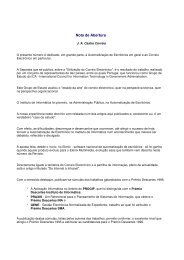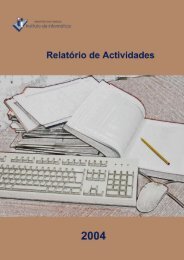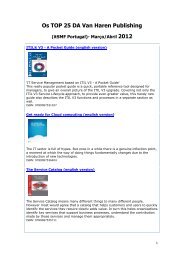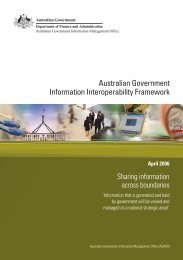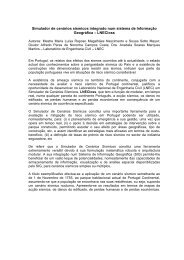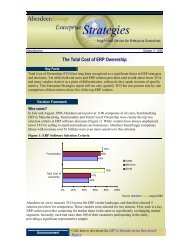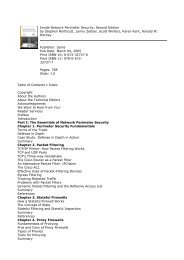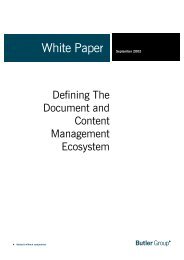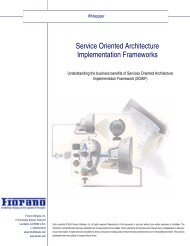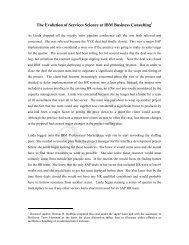OECD Peer Review of E-Government in Denmark - ePractice.eu
OECD Peer Review of E-Government in Denmark - ePractice.eu
OECD Peer Review of E-Government in Denmark - ePractice.eu
You also want an ePaper? Increase the reach of your titles
YUMPU automatically turns print PDFs into web optimized ePapers that Google loves.
Legal and regulatory barriers<br />
The Danish legal environment is appropriately supportive <strong>of</strong> e-government, be<strong>in</strong>g set up to<br />
enable, not h<strong>in</strong>der, digital communications. This is the result <strong>of</strong> both new legislation enabl<strong>in</strong>g<br />
e-government processes (e.g. the Act on Electronic Signatures) and efforts to simplify and modernise<br />
the legal environment, with a focus on ensur<strong>in</strong>g that it is compatible with digital communications.<br />
However, despite government achievements <strong>in</strong> develop<strong>in</strong>g a favourable legislative and regulatory<br />
environment for e-government, some perceived challenges related to the complexity <strong>of</strong> laws and<br />
regulations, and their lack <strong>of</strong> flexibility, still exist. While part <strong>of</strong> the problem may relate to cont<strong>in</strong>u<strong>in</strong>g<br />
deficiencies <strong>in</strong> the legal environment itself, it may also <strong>in</strong>dicate limited awareness among government<br />
organisations <strong>of</strong> the changes that have already been made, which could be imped<strong>in</strong>g them from<br />
mak<strong>in</strong>g best use <strong>of</strong> the updated environment. In common with other <strong>OECD</strong> countries, this may also<br />
underl<strong>in</strong>e a general lack <strong>of</strong> knowledge, capability, drive and <strong>in</strong>novation <strong>in</strong> <strong>in</strong>terpret<strong>in</strong>g laws and<br />
regulations, which can lead organisations to <strong>in</strong>correctly portray problems as be<strong>in</strong>g due to <strong>in</strong>adequate<br />
laws and regulations, rather than their own capabilities.<br />
Privacy and security<br />
Officials regard issues <strong>of</strong> privacy and security as be<strong>in</strong>g relatively less important challenges for the<br />
implementation <strong>of</strong> e-government <strong>in</strong> <strong>Denmark</strong>, reflect<strong>in</strong>g both a strong environment for data protection<br />
and security, and the generally high level <strong>of</strong> trust and confidence that Danes have <strong>in</strong> this aspect <strong>of</strong><br />
government operations; due, <strong>in</strong> part, to their long tradition <strong>of</strong> provid<strong>in</strong>g personal <strong>in</strong>formation to a<br />
range <strong>of</strong> public registers.<br />
Budgetary barriers<br />
A claimed lack <strong>of</strong> fund<strong>in</strong>g for e-government projects is the most important budgetary barrier to e-<br />
government revealed by this review. To the extent that this is a real barrier, it must be viewed <strong>in</strong> light<br />
<strong>of</strong> the implementation <strong>of</strong> the Structural Reform and the <strong>Government</strong>’s decision to f<strong>in</strong>ance the change<br />
process through sav<strong>in</strong>gs aris<strong>in</strong>g from <strong>in</strong>creased economies <strong>of</strong> scale and ga<strong>in</strong>s <strong>in</strong> efficiency, rather than<br />
with new funds. However, the relative flexibility <strong>of</strong> e-government fund<strong>in</strong>g sources suggests that<br />
compla<strong>in</strong>ts about lack <strong>of</strong> funds to implement e-government do not arise from a tight budgetary<br />
environment itself, but may be l<strong>in</strong>ked to a lack <strong>of</strong> <strong>in</strong>ternal flexibility to re-evaluate spend<strong>in</strong>g priorities<br />
and reassign funds <strong>in</strong> the face <strong>of</strong> budgetary constra<strong>in</strong>ts. Although work to address this is underway,<br />
the development and use <strong>of</strong> common approaches for creat<strong>in</strong>g robust bus<strong>in</strong>ess cases for e-government<br />
(which would assist <strong>in</strong> mak<strong>in</strong>g such decisions) is still immature <strong>in</strong> <strong>Denmark</strong>. A bus<strong>in</strong>ess case tool and<br />
support<strong>in</strong>g project management methodology has been developed for common use. However, there is<br />
still a need to communicate both its existence and the benefits <strong>of</strong> us<strong>in</strong>g it to government organisations,<br />
<strong>in</strong> support <strong>of</strong> its more widespread and consistent application.<br />
Lack <strong>of</strong> long-term budget<strong>in</strong>g horizons is also considered by many <strong>of</strong>ficials to be an important<br />
barrier to e-government. Some long-term spend<strong>in</strong>g mechanisms are already <strong>in</strong> place (e.g. the ability to<br />
carry forward unused appropriations, and borrow<strong>in</strong>g mechanisms), but it is not clear to what extent<br />
government organisations have effectively used them. This could simply <strong>in</strong>dicate a general lack <strong>of</strong><br />
knowledge <strong>of</strong> exist<strong>in</strong>g budget arrangements or, as expressed <strong>in</strong> <strong>in</strong>terviews, the presence <strong>of</strong> risk-averse<br />
attitudes towards us<strong>in</strong>g these mechanisms.<br />
A particular budgetary challenge frequently mentioned <strong>in</strong> <strong>in</strong>terviews was the so called<br />
“sow/harvest” problem. This challenge represents the fact that e-government <strong>in</strong>itiatives <strong>in</strong>volv<strong>in</strong>g<br />
more than one organisation <strong>of</strong>ten lead to disproportionate allocation <strong>of</strong> costs and benefits, thus<br />
creat<strong>in</strong>g differ<strong>in</strong>g and sometimes <strong>in</strong>compatible or perverse <strong>in</strong>centives for collaboration. The fact that<br />
11



